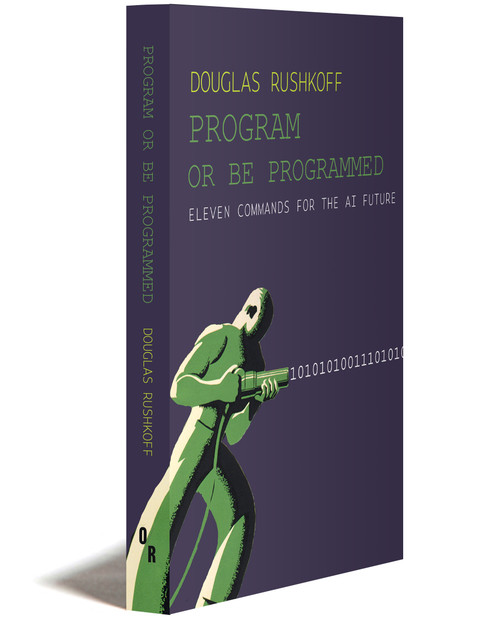Black Ops Advertising
“A well researched and accomplished book.”
—The New York Times“A startling and entertaining critique of new forms of advertising.”
—Counterfire.orgabout the bookabout
From Facebook to Talking Points Memo to the New York Times, often what looks like fact-based journalism is not. It’s advertising. Not only are ads indistinguishable from reporting, the Internet we rely on for news, opinions and even impartial sales content is now the ultimate corporate tool. Reader beware: content without a corporate sponsor lurking behind it is rare indeed.
Black Ops Advertising dissects this rapid rise of “sponsored content,” a strategy whereby advertisers have become publishers and publishers create advertising—all under the guise of unbiased information. Covert selling, mostly in the form of native advertising and content marketing, has so blurred the lines between editorial content and marketing message that it is next to impossible to tell real news from paid endorsements. In the 21st century, instead of telling us to buy, buy, BUY, marketers “engage” with us so that we share, share, SHARE—the ultimate subtle sell.
Why should this concern us? Because personal data, personal relationships, and our very identities are being repackaged in pursuit of corporate profits. Because tracking and manipulation of data make “likes” and tweets and followers the currency of importance, rather than scientific achievement or artistic talent or information the electorate needs to fully function in a democracy. And because we are being manipulated to spend time with technology, to interact with “friends,” to always be on, even when it is to our physical and mental detriment.
“There is no need for advertisements to look like advertisements. If you make them look like editorial pages, you will attract about 50 per cent more readers. You might think that the public would resent this trick, but there is no evidence to suggest that they do.”
—David Ogilvy, founder, Ogilvy & Mather
“Black Ops Advertising provides a powerful cultural critique about the changing media landscape and what it now means to be a consumer of it as our (social) conversations become markets. It's also a reality check for brands, particularly those ones that have realized that being more customer-obsessed means playing a more positive role in society and for that to go beyond an ad slogan-like hashtag.”
—Justin Kirby, curator, Best of Branded Content Marketing (BOBCM)
“Reading Mara Einstein is like putting on magic glasses that let you see the advertising all around you, all the time. Whether you're looking to sell, or hoping to resist, here is the state of the art.”
—Douglas Rushkoff, author, Throwing Rocks at the Google Bus, Present Shock and Program or Be Programmed
About The Author / Editor
Preview
….Even with twenty-plus years of marketing experience, I didn’t initially realize this was an advertising ploy. I watched the jump as others had and never once thought I was being sold an extreme energy drink. I thought I was watching news.
After I discovered Red Bull’s involvement, though, I felt used. Okay, so Red Bull doesn’t want to use traditional advertising. Fine. But if the content is worthy of my attention why aren’t they willing to put their name on it? The answer is easy: Red Bull is well aware that if I knew there was an advertiser involved, I—and likely most of us—would not watch it. Years of remote controls, DVRs, and now “banner blindness” and ad blockers have taught advertisers that consumers are utterly adept at circumventing advertising. In response, they have turned to new and improved forms of clandestine marketing.
Obscured persuasion, broadly known as stealth marketing, is defined “as the use of surreptitious marketing practices that fail to disclose or reveal the true relationship with the company that produces or sponsors the marketing message.”[i] While not new, these hidden marketing practices have reached new heights and more devious methods in the age of social media. And with those methods have come a multitude of names—covert marketing, undercover marketing, embedded marketing and more recently, content marketing, native advertising, buzz marketing, and brand journalism, among many, many others. There are few straightforward definitions for these strategies, but the goal is clear: find ways to get products in front of people without them realizing they are being persuaded to purchase and—the piece de resistance—get them to push the products to their friends, creating a world where we are in a constant state of buying or selling.
Whatever the label, however, it comes down to this: advertisers can camouflage their sales message in only one of two ways 1) hide the advertising within existing content environments or 2) create the pitch themselves and make it look like something other than advertising. The first of these is native advertising, the second content marketing.
Native advertising is a sales pitch created to be seamlessly integrated into a website or social media feed so visitors will click on the advertiser-sponsored content as readily as they do the non-sponsored editorial. The best example of this is BuzzFeed, a popular source for news and information online. Anyone who has spent time on the site or the app, or had BuzzFeed content forwarded through social media, has been privy to “listicles” like “51 Thoughts Every Lady Who Shaves Her Legs Has Had” or “12 Life Lessons We all Learned Our Freshman Year of College” or quizzes like “What Fraggle Rock Character Are You?” The difference with the middle one is that it is sponsored by Target, an advertiser targeting students going back to school. How do you know this? Because of a teeny, tiny little orange rectangle that says “promoted by” located on top of an equally small logo. But native advertising isn’t only on BuzzFeed. It’s on Facebook and Twitter and even The New York Times website, which launched its in-house marketing group with a piece about women in prison which was sponsored by the Netflix’s series Orange is the New Black.[ii]
in the media
Black Ops Advertising
“A well researched and accomplished book.”
—The New York Times“A startling and entertaining critique of new forms of advertising.”
—Counterfire.orgabout the bookabout
From Facebook to Talking Points Memo to the New York Times, often what looks like fact-based journalism is not. It’s advertising. Not only are ads indistinguishable from reporting, the Internet we rely on for news, opinions and even impartial sales content is now the ultimate corporate tool. Reader beware: content without a corporate sponsor lurking behind it is rare indeed.
Black Ops Advertising dissects this rapid rise of “sponsored content,” a strategy whereby advertisers have become publishers and publishers create advertising—all under the guise of unbiased information. Covert selling, mostly in the form of native advertising and content marketing, has so blurred the lines between editorial content and marketing message that it is next to impossible to tell real news from paid endorsements. In the 21st century, instead of telling us to buy, buy, BUY, marketers “engage” with us so that we share, share, SHARE—the ultimate subtle sell.
Why should this concern us? Because personal data, personal relationships, and our very identities are being repackaged in pursuit of corporate profits. Because tracking and manipulation of data make “likes” and tweets and followers the currency of importance, rather than scientific achievement or artistic talent or information the electorate needs to fully function in a democracy. And because we are being manipulated to spend time with technology, to interact with “friends,” to always be on, even when it is to our physical and mental detriment.
“There is no need for advertisements to look like advertisements. If you make them look like editorial pages, you will attract about 50 per cent more readers. You might think that the public would resent this trick, but there is no evidence to suggest that they do.”
—David Ogilvy, founder, Ogilvy & Mather
“Black Ops Advertising provides a powerful cultural critique about the changing media landscape and what it now means to be a consumer of it as our (social) conversations become markets. It's also a reality check for brands, particularly those ones that have realized that being more customer-obsessed means playing a more positive role in society and for that to go beyond an ad slogan-like hashtag.”
—Justin Kirby, curator, Best of Branded Content Marketing (BOBCM)
“Reading Mara Einstein is like putting on magic glasses that let you see the advertising all around you, all the time. Whether you're looking to sell, or hoping to resist, here is the state of the art.”
—Douglas Rushkoff, author, Throwing Rocks at the Google Bus, Present Shock and Program or Be Programmed
About The Author / Editor
Preview
….Even with twenty-plus years of marketing experience, I didn’t initially realize this was an advertising ploy. I watched the jump as others had and never once thought I was being sold an extreme energy drink. I thought I was watching news.
After I discovered Red Bull’s involvement, though, I felt used. Okay, so Red Bull doesn’t want to use traditional advertising. Fine. But if the content is worthy of my attention why aren’t they willing to put their name on it? The answer is easy: Red Bull is well aware that if I knew there was an advertiser involved, I—and likely most of us—would not watch it. Years of remote controls, DVRs, and now “banner blindness” and ad blockers have taught advertisers that consumers are utterly adept at circumventing advertising. In response, they have turned to new and improved forms of clandestine marketing.
Obscured persuasion, broadly known as stealth marketing, is defined “as the use of surreptitious marketing practices that fail to disclose or reveal the true relationship with the company that produces or sponsors the marketing message.”[i] While not new, these hidden marketing practices have reached new heights and more devious methods in the age of social media. And with those methods have come a multitude of names—covert marketing, undercover marketing, embedded marketing and more recently, content marketing, native advertising, buzz marketing, and brand journalism, among many, many others. There are few straightforward definitions for these strategies, but the goal is clear: find ways to get products in front of people without them realizing they are being persuaded to purchase and—the piece de resistance—get them to push the products to their friends, creating a world where we are in a constant state of buying or selling.
Whatever the label, however, it comes down to this: advertisers can camouflage their sales message in only one of two ways 1) hide the advertising within existing content environments or 2) create the pitch themselves and make it look like something other than advertising. The first of these is native advertising, the second content marketing.
Native advertising is a sales pitch created to be seamlessly integrated into a website or social media feed so visitors will click on the advertiser-sponsored content as readily as they do the non-sponsored editorial. The best example of this is BuzzFeed, a popular source for news and information online. Anyone who has spent time on the site or the app, or had BuzzFeed content forwarded through social media, has been privy to “listicles” like “51 Thoughts Every Lady Who Shaves Her Legs Has Had” or “12 Life Lessons We all Learned Our Freshman Year of College” or quizzes like “What Fraggle Rock Character Are You?” The difference with the middle one is that it is sponsored by Target, an advertiser targeting students going back to school. How do you know this? Because of a teeny, tiny little orange rectangle that says “promoted by” located on top of an equally small logo. But native advertising isn’t only on BuzzFeed. It’s on Facebook and Twitter and even The New York Times website, which launched its in-house marketing group with a piece about women in prison which was sponsored by the Netflix’s series Orange is the New Black.[ii]










